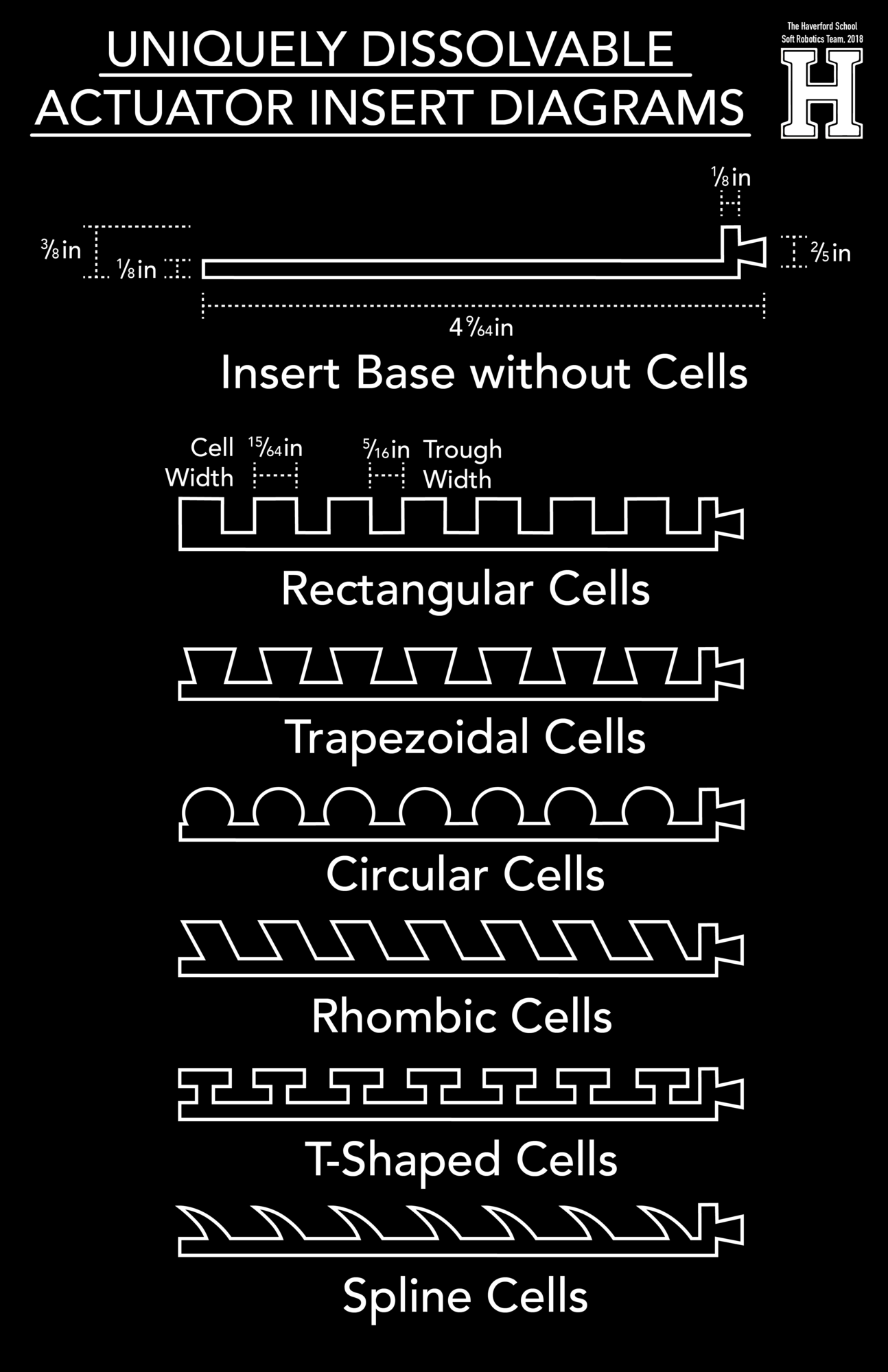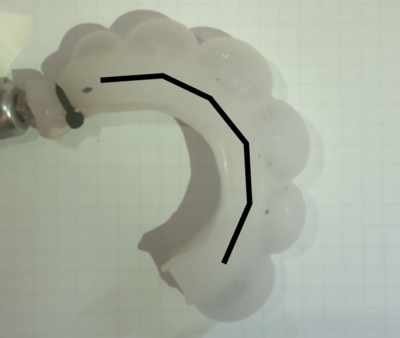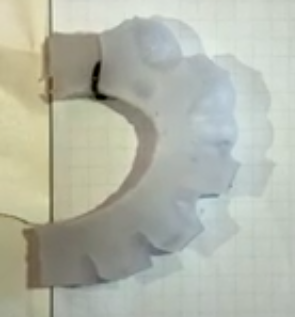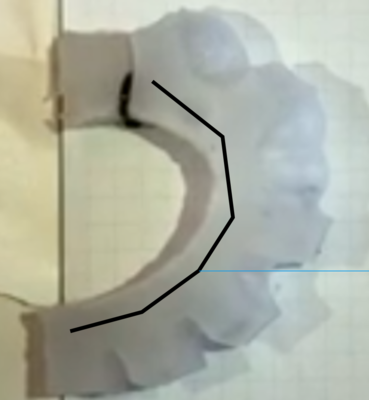The King Actuator
Solubility Testing
Prior to using the PVA inserts in our actuators, the King Actuator inserts were carved using PS, more commonly known as styrofoam. These inserts had to be cut by hand, a tedious and time consuming process. In addition, the factor of human error made it nearly impossible to ensure that the cells of the insert were identical to each other. This was not ideal because the actuators would never turn out identical, removing the possibility of consistency within our tests. We noticed that PS inserts were less dense than the silicone that covered them, meaning that the inserts would float to the top or shift into undesirable positions during the curing process. However, the PS inserts had one outstanding benefit: they instantly dissolved when they came in contact with acetone. Despite this, the various drawbacks led us to look into a 3D-printed filament that was easily soluble, allowing for a more consistent and reproduceable actuator. After some research, we decided that using PVA as the filament would yield the best results.
A quick comparison of the two materials yields:
Comparative Analysis of Polyvinyl Alcohol and Polystyrene
| Material | Polyvinyl Alcohol (PVA) | Polystyrene (PS) |
| Profile | Hollow | Solid |
| Durability | Durable | Fragile |
| Production | 3-D Printed | Hand Cut |
| Solubility | Water | Acetone |
| Dissoving Time | ~ hours depending on temperature | Instantly |
We conducted a dissolution test on two 3D-printed PVA inserts to gain a better understanding of the rate at which they dissolved. While we knew that the inserts dissolve faster in warmer water due to increased energy in the system, we also wanted to quantify the total time it would take to dissolve and the change in time increased temperature provides. Since the actuators became maleable after exposure to water, gathering quantitaive data such as mass in relation to time was not feasible. Instead, we designed an experiment where we took photos of the two inserts in different temperature solvents during noteworthy occurances and spaced intervals to collect qualitative data. The first hot plate was prehated to 100°C while the other was preheated to 200°C, with the masses of the two PVA internals being nearly identical (2.78 and 2.81 grams, respectively).
| Time Elapsed (minutes) | Images | Notes |
| 0 |
|
Our testbed with one heatbed preheated to 100°C (Left) and the other at 200°C (Right). The inserts have not been exposed to the water at this point in time. |
| 1 |
|
No distinguishable change. |
| 5 |
|
No distinguishable change. |
| 10 |
200C
|
Visible difference between the 100°C (Left) and 200°C (Right) inserts. The 200°C insert began bubling, dissovling, and slightly arching. |
| 15 |
|
The 100°C (Left) insert began arching similar to 200°C insert at 10 minutes. However the water of 200°C (Right) insert became murky, a sign of dissolving. |
| 20 |
|
The 200°C (Right) insert arched deeply. |
| 30 |
100°C
|
The 100°C (Left) insert began arching similarly. |
| 37 |
100°C
200°C
|
The 100°C insert continues to arch. The 200°C however began to arch inwardly, perhaps a sign of little support material the the two points around the clamp. |
| 55 |
100°C
200°C
|
The water for both inserts has become translucent. By this time the 200°C insert was completly dissolved. |
| 90 |
|
Finally the 100°C insert has dissolved. |
This experiment shed light on the benefits of using hotter water, specifically comparing the effectiveness of the two temperatures. However, after we successfully dissolved PVA inserts in our final claw mold, we noted that only the first few cavaties of the insert were exposed to heated water. In essense, only exposed portions of PVA dissolved, forcing us to cycle between dissolving and emptying maleable chunks in order to empty an actuator. While the experiement was successful, the outcome desmonstrated the lack of feasibility of the process in the application. Initially, we judged that the PVA insert was more ideal because of its versatility. However, the dissolution process was more tedious .
If we were to further this project we would do more in depth research in finding a 3D-printable material that completely and instantly dissolves in a solvent. We were considering using Acrylonitrile Butadiene Styrene (ABS) filament instead of the PVA because it dissolves quicker in acetone. The drawback is that we do not have the proper ventilation to safely print the ABS inserts. In addition, we could explore materials that could be cast into a insert mold and later dissolve the insert. This action would ultimately opened our options for more materials aside from 3D-printed ones.
Durability Testing
To confirm the quality of the King Actuator, we performed durability tests comparing various versions of the actuator and a PnueNet. We argued that solid tensile strength and ability to actuate with a high pressure airflow would accurately portray the quality and durability of the actuator. After fabricating actuators of comparable size, we inflated them using a Ryobi Power Inflator until they ruptured or delaminated. Using 240fps slow motion video, we noted PSI changes and when the actuator failed. This data shows us which actuator is able to withstand more pressure and which is the most durable for various applications.
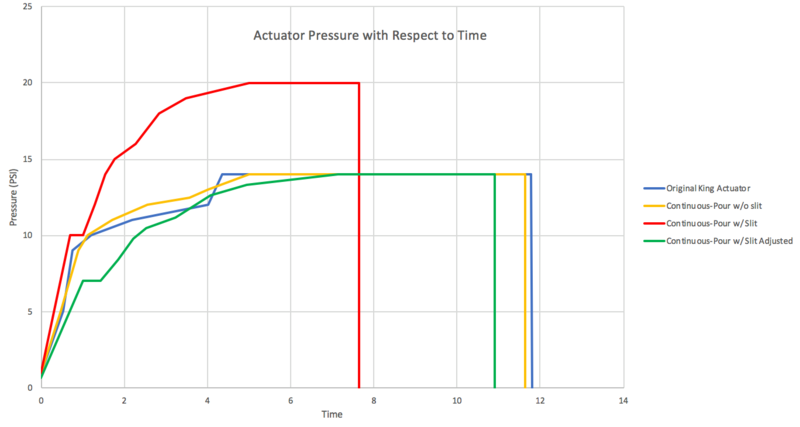
You can view vidoes of these pressures tests here.
While collecting the data, we experienced inconsistencies in PSI output from the pump because we did not charge the battery between tests for the Final Slit actuator and the PnueNet. As a result, the data may have been scaled differently. To compensate for this, we assumed there was a direct correlation between the maximum recorded PSI and the output PSI, and scaled the data down by a ratio of the maximum PSI of one line to the average of the other two, normalizing the data. From analyzing both data sets and the video, it was evident our single body actuators far outperformed the PnueNets. While the PnueNets delaminated instantly, the other actuators, (The Original King and the Continous Pour with and without slits) survived longer. We were not able to record any data for the PnueNets because it delaminated and burst instantly. However, our actuators still suffered problems. Each of our actuators failed when an air pocket opened between the fabric and silicone. The reason for failure is similar among all of the actuator types; when scaled down, all of our actuators failed at a similar point, further justifying the issue between the seal.
Qualitative Testing
A major component of any pneumatic actuator is its ability to bend with applied pressure. We plotted the curve of the actuators and compared thier general shape.
| Original King | Continuous Pour (No Slits) | Continous Pour (With Slits) |
|
|
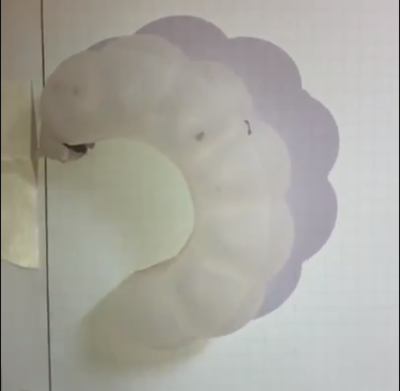 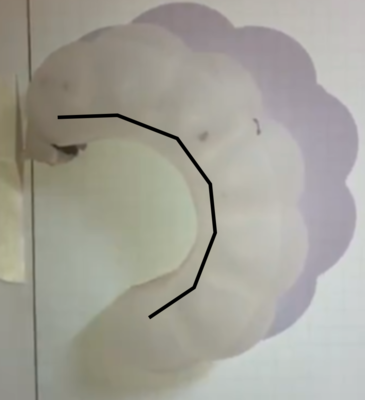
|
|
All of the actuators arched similarly, although the slotted continous pour expanded within each section, causing the actuator to bend more at the start. In addition, the Continuous Slotted actuator we used had a manufacturing defect where the internal bent the oneside, causing a non-uniform curvature.
Insert Qualitative Testing
One of the benefits of using a 3D printed insert is that we can change and play with the shape of the cavites formed in the actuator when the PVA is dissolved, giving it its modularity. We 3D printed a set of variable inserts to make actuators out of and see how they impact actuation. We tested some of the internals proposed and noticed no significant visual differences between the different internal shapes in terms of actuation. This is likely due to the fact that as air gets pushed into the cavities it tends to push in the same pattern, thus no matter the shape and size of the cavity the expansion of the cavity will remain the same shape. For the future we would like to create more actuators with these variable shapes and test more volumes out to see if it really has no effect on actuation. However we did notice that the more complicated the shapes got, the harded the actuators were to actuate and remove the inserts from.
